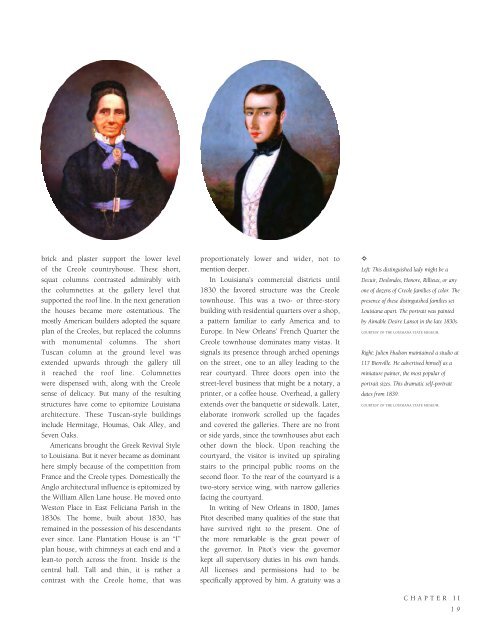Historic Louisiana
An illustrated history of Louisiana, paired with the histories of companies, families and organizations that make the state great.
An illustrated history of Louisiana, paired with the histories of companies, families and organizations that make the state great.
You also want an ePaper? Increase the reach of your titles
YUMPU automatically turns print PDFs into web optimized ePapers that Google loves.
ick and plaster support the lower level<br />
of the Creole countryhouse. These short,<br />
squat columns contrasted admirably with<br />
the columnettes at the gallery level that<br />
supported the roof line. In the next generation<br />
the houses became more ostentatious. The<br />
mostly American builders adopted the square<br />
plan of the Creoles, but replaced the columns<br />
with monumental columns. The short<br />
Tuscan column at the ground level was<br />
extended upwards through the gallery till<br />
it reached the roof line. Columnettes<br />
were dispensed with, along with the Creole<br />
sense of delicacy. But many of the resulting<br />
structures have come to epitomize <strong>Louisiana</strong><br />
architecture. These Tuscan-style buildings<br />
include Hermitage, Houmas, Oak Alley, and<br />
Seven Oaks.<br />
Americans brought the Greek Revival Style<br />
to <strong>Louisiana</strong>. But it never became as dominant<br />
here simply because of the competition from<br />
France and the Creole types. Domestically the<br />
Anglo architectural influence is epitomized by<br />
the William Allen Lane house. He moved onto<br />
Weston Place in East Feliciana Parish in the<br />
1830s. The home, built about 1830, has<br />
remained in the possession of his descendants<br />
ever since. Lane Plantation House is an “I”<br />
plan house, with chimneys at each end and a<br />
lean-to porch across the front. Inside is the<br />
central hall. Tall and thin, it is rather a<br />
contrast with the Creole home, that was<br />
proportionately lower and wider, not to<br />
mention deeper.<br />
In <strong>Louisiana</strong>’s commercial districts until<br />
1830 the favored structure was the Creole<br />
townhouse. This was a two- or three-story<br />
building with residential quarters over a shop,<br />
a pattern familiar to early America and to<br />
Europe. In New Orleans’ French Quarter the<br />
Creole townhouse dominates many vistas. It<br />
signals its presence through arched openings<br />
on the street, one to an alley leading to the<br />
rear courtyard. Three doors open into the<br />
street-level business that might be a notary, a<br />
printer, or a coffee house. Overhead, a gallery<br />
extends over the banquette or sidewalk. Later,<br />
elaborate ironwork scrolled up the façades<br />
and covered the galleries. There are no front<br />
or side yards, since the townhouses abut each<br />
other down the block. Upon reaching the<br />
courtyard, the visitor is invited up spiraling<br />
stairs to the principal public rooms on the<br />
second floor. To the rear of the courtyard is a<br />
two-story service wing, with narrow galleries<br />
facing the courtyard.<br />
In writing of New Orleans in 1800, James<br />
Pitot described many qualities of the state that<br />
have survived right to the present. One of<br />
the more remarkable is the great power of<br />
the governor. In Pitot’s view the governor<br />
kept all supervisory duties in his own hands.<br />
All licenses and permissions had to be<br />
specifically approved by him. A gratuity was a<br />
✧<br />
Left: This distinguished lady might be a<br />
Decuir, Deslondes, Honore, Rillieux, or any<br />
one of dozens of Creole families of color. The<br />
presence of these distinguished families set<br />
<strong>Louisiana</strong> apart. The portrait was painted<br />
by Aimable Desire Lansot in the late 1830s.<br />
COURTESY OF THE LOUISIANA STATE MUSEUM.<br />
Right: Julien Hudson maintained a studio at<br />
117 Bienville. He advertised himself as a<br />
miniature painter, the most popular of<br />
portrait sizes. This dramatic self-portrait<br />
dates from 1839.<br />
COURTESY OF THE LOUISIANA STATE MUSEUM.<br />
CHAPTER II<br />
19
















